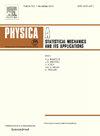用于静息态功能磁共振成像时空动态分析的新型图神经网络框架
IF 2.8
3区 物理与天体物理
Q2 PHYSICS, MULTIDISCIPLINARY
Physica A: Statistical Mechanics and its Applications
Pub Date : 2025-04-14
DOI:10.1016/j.physa.2025.130582
引用次数: 0
摘要
背景:图神经网络(gnn)是研究脑功能连通性和神经网络活动的必要手段,但静息状态功能磁共振成像(rs-fMRI)的高维数和复杂性及其时空动态特性给传统的gnn在时空动态分析方面带来了挑战。方法:提出了一种新的GNN框架,旨在对rs-fMRI数据进行时空动态分析。该框架根据rs-fMRI数据构建静态空间图和动态时间图。然后,使用GNN提取空间特征,使用长短期记忆网络(LSTM)捕获动态时间特征。采用扩散连接策略,促进静态空间信息与动态时间信息的交互,增强模型的稳定性和泛化能力。为了实现有效的时空信息融合,提出了一种基于自注意机制的自适应融合方法,提高了模型对复杂时空模式的表征能力。结果:在两个公开数据集上的实验结果表明,该框架在脑区域连接分类任务中表现优异。与传统方法和现有GNN模型相比,该框架显著提高了分类精度和模型鲁棒性,证明了其在rs-fMRI数据分析中的优越性和实用性。结论:提出的GNN框架为rs-fMRI数据的时空动态分析提供了一个有效的工具。该方法不仅增强了对复杂脑网络结构的理解,而且在实际应用中显示出巨大的潜力,有望推动脑科学的进一步研究。本文章由计算机程序翻译,如有差异,请以英文原文为准。
A novel graph neural network framework for resting-state functional MRI spatiotemporal dynamics analysis
Background:
Graph neural networks (GNNs) are essential for studying brain functional connectivity and neural network activity, but the high dimensionality and complexity of resting-state functional magnetic resonance imaging (rs-fMRI), coupled with its spatiotemporal dynamic characteristics, pose challenges for traditional GNNs in spatiotemporal dynamic analysis.
Methods:
This paper proposes a novel GNN framework aimed at the spatiotemporal dynamic analysis of rs-fMRI data. The framework constructs static spatial graphs and dynamic temporal graphs from rs-fMRI data. Then, a GNN is employed to extract spatial features, and a long short-term memory network (LSTM) is used to capture dynamics temporal features. Additionally, a diffusion connection strategy is implemented to facilitate the interaction between static spatial information and dynamic temporal information, enhancing the model’s stability and generalization capability. To achieve effective fusion of spatiotemporal information, an adaptive fusion method based on a self-attention mechanism is introduced, which improves the model’s ability to represent complex spatiotemporal patterns.
Results:
Experimental results on two public datasets demonstrate that this framework performs excellently in brain region connectivity classification task. Compared to traditional methods and existing GNN models, this framework significantly improves classification accuracy and model robustness, proving its superiority and practicality in the analysis of rs-fMRI data.
Conclusion:
The proposed GNN framework provides an effective tool for spatiotemporal dynamic analysis of rs-fMRI data. This method not only enhances the understanding of complex brain network structures but also shows great potential in practical applications, promising to advance further research in brain science.
求助全文
通过发布文献求助,成功后即可免费获取论文全文。
去求助
来源期刊
CiteScore
7.20
自引率
9.10%
发文量
852
审稿时长
6.6 months
期刊介绍:
Physica A: Statistical Mechanics and its Applications
Recognized by the European Physical Society
Physica A publishes research in the field of statistical mechanics and its applications.
Statistical mechanics sets out to explain the behaviour of macroscopic systems by studying the statistical properties of their microscopic constituents.
Applications of the techniques of statistical mechanics are widespread, and include: applications to physical systems such as solids, liquids and gases; applications to chemical and biological systems (colloids, interfaces, complex fluids, polymers and biopolymers, cell physics); and other interdisciplinary applications to for instance biological, economical and sociological systems.

 求助内容:
求助内容: 应助结果提醒方式:
应助结果提醒方式:


